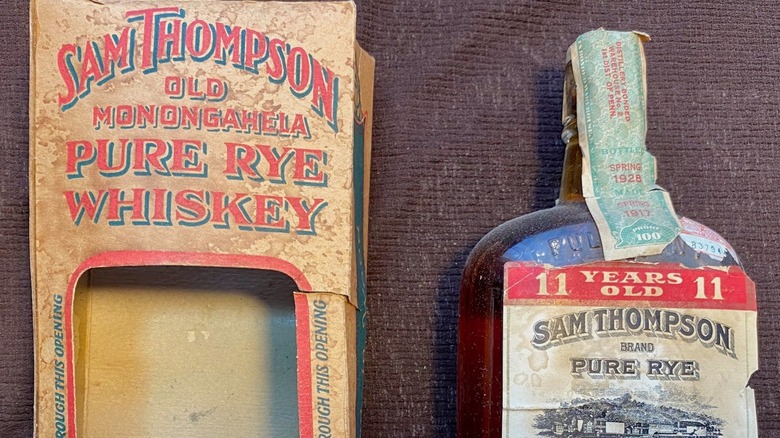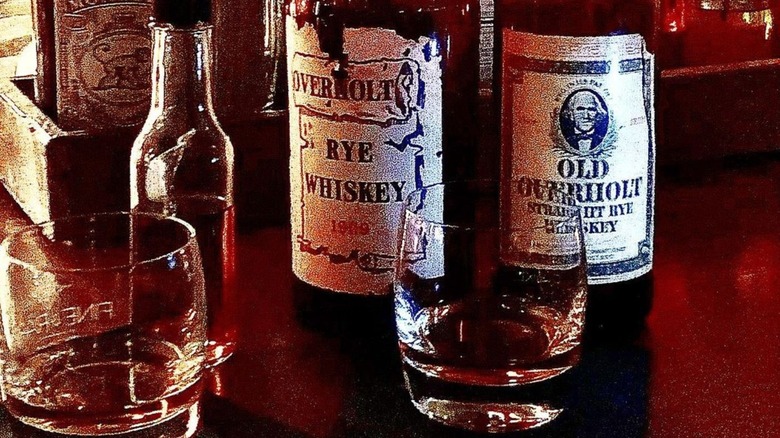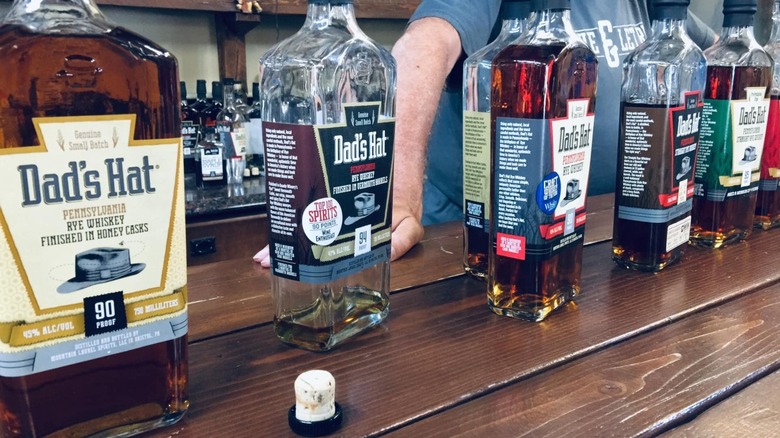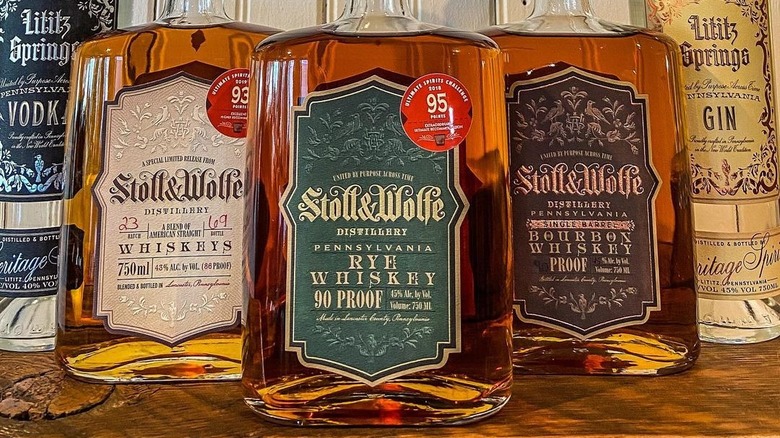The Historic American Whiskey You've Probably Never Heard Of
The U.S. has been in the midst of an unprecedented bourbon boom for over a decade now, and given its rich history even before its latest surge in popularity, it's fair to say that the classic Kentucky spirit (95% of all bourbon is made in Kentucky, per Drizly) is now firmly entrenched as the classic American spirit.
But famed as this whiskey-style unquestionably is, did you know that by 1821, when the word bourbon first appeared in advertisement print in a Kentucky newspaper (per the Whisky Advocate), another regional whiskey was already much more famous that had a much longer track record of success? And did you know that it was this whiskey that was at the root of the infamous Whiskey Rebellion of 1794, when President George Washington mobilized federal forces to enforce a tax on whiskey? (via The New York Times)
Meet Old Monongahela, a rye whiskey produced in parts of Pennsylvania and Maryland (the southwestern region of the former, the northwestern region of the latter) since the 18th century, per Punch. This whiskey style, the country's first to be widely known, fell out of favor during Prohibition in the early 20th century. But after nearly a century of obscurity, it is rising to reclaim its rightful place in the American spirits firmament, thanks to the efforts of a new generation of regional distillers.
The history of Old Monongahela rye
There are two historical incidents invariably mentioned in connection with Old Monongahela rye whiskey. The first is the aforementioned Whiskey Rebellion, when President Washington imposed a tax on distillers to help pay off war debt and Secretary of the Treasury Alexander Hamilton rode at the head of federal troops to enforce it; the latter after Western Pennsylvania farmers and distillers, led by Philip Wigle, rose up in revolt, per The New York Times. Some residents in the Old Monongahela region still hang paintings of Alexander Hamilton upside down in a centuries old mark of disrespect.
The other is the regional rye's inclusion in the great American novel, "Moby Dick," in which author Herman Melville compares the color of whale's blood to Old Monongahela, per Bourbon Veach. Both incidents point to the once widespread popularity of the whiskey style, which originated with Scots-Irish and Pennsylvania Dutch settlers. By 1810, in fact, Pennsylvania was producing nearly three times more whiskey than Kentucky, notes Pennington Distilling Co. Regional whiskey makers like Old Overholt, which was made at the now abandoned Broad Ford distillery, were among the nation's best known during the late 19th and early 20th century. (via Whisky Advocate)
Rye reached its crescendo during the Roaring Twenties when it was the main ingredient in dozens of popular cocktails. But as Punch reports, the Old Monongahela region never recovered after Prohibition and the style fell into obscurity until its recent revival.
What qualifies a whiskey as Old Monongahela rye?
Old Monongahela as a style of whiskey is defined by a number of factors, the most important of which is location. It's the Monongahela River — with headwaters in West Virginia and a terminus in Pittsburgh, where it joins in confluence with the Allegheny to create the Ohio River — which gives this regional whiskey its name and its bedrock characteristic; namely, per Punch, that limestone deposits in the region imbue the river and its tributaries with calcium bicarbonate, which adds minerality and helps fermentation.
The mash bill, or recipe, for Old Monongahela is also distinct. Unlike bourbon, which is required by law to be 51% corn (with the remainder grains including wheat, rye, and barley), Old Monangahela whiskeys traditionally use only rye and barley malt, notes Whisky Advocate. As the name suggests, rye predominates, comprising as much as 80% of the mash bill. Old Monongahela also differs from most contemporary whiskeys in using a sweet rather than sour, meaning fresh yeast is added for every new fermentation.
Barrel aging and a three-chamber are the other characteristics most closely associated historically with the Old Monongahela-style. The three-chamber still, for instance, was commonly used during the 19th century, but became such an anachronism by the 21st that when Denver small-batch distiller Leopold Bros., could not find one to make traditional rye. Instead, one was custom made for the distiller. It is reportedly the first one built since Prohibition (per Whisky Advocate).
Don't call it a comeback (it's been here for centuries)
There are no longer any three chamber stills in the Old Monongahela region today. However, the new generation of distillers emerged, seeking to keep the tradition alive, albeit with modern refinements. Mountain Laurel Spirits, maker of Dad's Hat Rye, opened their doors in 2010 and helped to jumpstart the Pennsylvania whiskey-making resurgence, according to The New York Times. Mountain Laurel is a town located in Bristol near Philadelphia. It's not in the Old Monongahela region, but other new distillers have since opened in more traditional localities.
Stoll and Wolfe Distillery, for instance, opened in Lititz, Pennsylvania in 2017. One of its namesakes, Dick Stoll, was a great whiskey maker in the classic Old Monongahela tradition, and helped to connect the tradition to the newer generation before his death in 2020, per The New York Times. Wigle Whiskey, named for one of the leaders of the Whiskey Rebellion, is a craft distillery which opened in 2011 in Pittsburgh. The distiller is making rye whiskey in the Old Monongahela style, sourcing its rye regionally and milling it in its own distillery. Liberty Pole Spirits in Washington, Pennsylvania, meanwhile, is also carrying the banner forward for Old Monongahela, making rye whiskey with a traditional high rye mash bill.
So the next time you're looking for an authentic whiskey, be sure to also look for not only Kentucky, but also Pennsylvania and Maryland.



